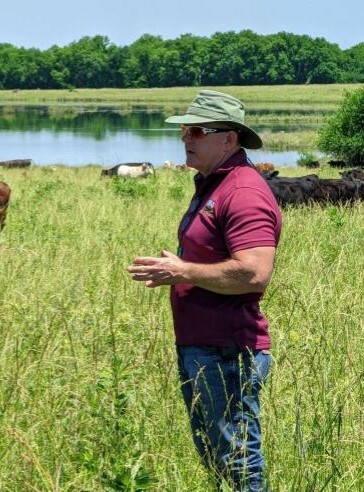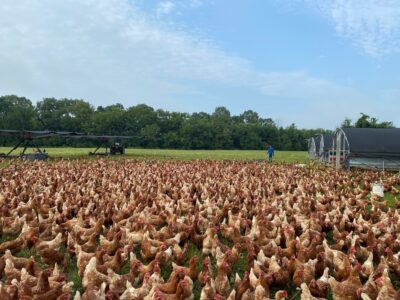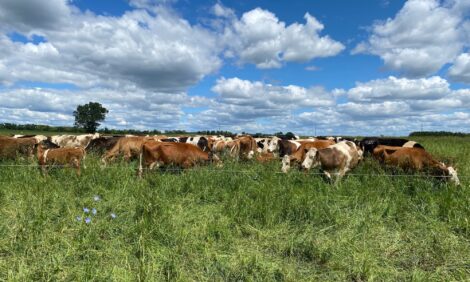



What exactly is regenerative grazing?
Expert Allen Williams demystifies regenerative grazingPart of Series:
Next Article in Series >

Many buzzwords surround developments in agriculture like regenerative grazing, adaptive grazing and rotational grazing as we move towards incorporating more sustainable practices into our farms. Rotational grazing simply means routinely moving one’s livestock to a new place to graze. However, regenerative grazing, synonymous with adaptive grazing, has a more complex meaning.
Dr. Allen Williams, a 6th generation family farmer and founding partner of the consulting group Understanding Ag, gives a description of regenerative grazing in the US.
Regenerative grazing: Repair, rebuild, revitalize and restore ecosystems
“Regenerative grazing is grazing in a manner that allows us to be able to tap into the four ecosystem processes: to repair, rebuild, revitalize and restore ecosystem function,” Williams said.
Williams describes this process as one with many high-level observations that is continuously adjusting, based on conditions and time, what is being done every single day to ensure that the grazing impact synchronizes with the environment, climate and ecosystem involved in the farm.
“It starts with life beneath the soil and then translates to life above. I'm thinking about how I am feeding the microbes underneath my feet because they are critically important to me and my success as a farmer or rancher,” he said. “Then, I'm thinking about my plants: am I grazing in a way that's going to benefit my plants and in a way that is going to allow them to be able to recover more rapidly from the grazing impact to have optimum nutrient cycling and facilitate the water cycle through those plants while maximizing photosynthetic capture?”
Williams explains that traditional grazing methods are highly prescriptive. This means that farmers repeat the same practices day after day. He notes this is problematic for several reasons.
“What we find is that in nature, there is no such thing as stasis. Everything is constantly shifting and changing, and if we're implementing a prescriptive system, then sooner or later we're going to hit a roadblock,” he comments. “It impedes and even narrows biodiversity in that ecosystem. It impedes our ability to continuously build carbon and organic matter in our soils and to infiltrate and retain water from natural precipitation or applied irrigation. Thus, it impacts overall performance of our livestock and our profitability.”
One major problem faced by conventional grazing practices is total potential for forage biomass production – or how much can be grown on any given acre – is capped.
“Conventional grazing practices without added inputs are only going to produce so much forage. That's why a lot of farmers and ranchers find themselves in a position of buying and applying external fertility,” he said. “With regenerative grazing, we find that we can steadily and incrementally improve and increase forage biomass production without buying and applying fertility. The fertility is applied through the very animals that are actively grazing out there just like nature does it with wild ruminants.”
Another major problem faced by conventional grazing practices is a sharp decrease of plant diversity.
“We see a narrowing of plant species diversity out there, and the reason for that is the prescriptive, conventional grazing practices are always going to favor a very select group of plants. The other species that are out there are going to diminish greatly and even drop out of the ecosystem,” he said.
Rather than focus on a select group of plants, Williams recommends relying on the natural seedbank of the ecosystem of one’s farm to provide diversity in the grazers’ diets.

“With regenerative grazing, we see dozens and dozens of plant species responding from the native latent seed bank. And those species will proliferate. It's far better to allow the latent seed bank to provide that response,” he explained.
For example, Williams works with a farm in Alabama that saw significant plant diversity increases as a result of regenerative grazing practices compared to conventional grazing.
“I have now documented more than 150 different plant species that are growing in our pastures from the latent seed bank. However, if you look at most pasture and range land following conventional grazing practices, there will be no more than three to six dominant species in the average pasture,” he said.
A common question in regard to alternative grazing methods is whether or not it requires more or less land for the same amount of cattle.
“Regenerative grazing doesn't require more land, and we are actually far more productive on the same acres,” Williams said. “Over time, it requires less land without all of the purchased and added inputs.”
He mentions that typical ranching operations in the US today are only cow-calf, but he recommends farmers diversify their enterprise to get the most value out of every acre.

“In our regenerative ranches and farms, we've got multiple species of livestock that are having a very positive ecological impact on the landscape because that is simulating what used to happen in the wild.”
Using regenerative practices farmers can stack other livestock operations onto their land without needing to increase their acreage. Cattle, sheep, goats, poultry, pigs and honeybees could all graze and forage on the same pastureland.
“On my farm, for example, the same acres that we could conventionally run 800 head of cows, we are still running 800 head of cows with more than 500 pigs, more than 5,000 chickens and more than 500 sheep. Plus, we'll run hundreds of beehives,” Williams explained. “That’s the beauty of regenerative agriculture – I can produce far more food per acre every single year that I can with conventional agriculture.”
Don’t miss Part 2 of our interview with Dr. Williams - Regeneratively grass-fed beef can be 85% more nutrient dense than conventionally raised beef




